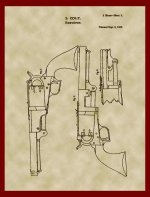CaptainCrossman
Moderator
original 1850 Colt patent
what's that under the barrel/frame on the first picture at left, in this 1850 Colt patent ? looks like Sam Colt was doing the same thing, 160 years ago. so how bad can the "hot rod" pistol on GB be ?
but I already know what you fellas are gonna say, Sam Colt, what did he know, a real dummy, wasn't he, I'm suspicious, that drawing sounds a lot like someone else, blah blah, woof woof, nothing he could design or make, could ever match one of your authentic Italian $129 repro brassers, that topstrap would make it stronger but peen the frame, etc., etc., right ? ]
]
notice the added TOPSTRAP on the Colt pistol, patented by Sam Colt himself.
notice the screws facing rearward, where the dowel pins used to be in the bottom of frame, to hold barrel on
notice the text "and that by the means of connection the barrel is firmly secured"-Sam Colt wasn't too concerned about frame being peened- he was concerned with holding the barrel on the gun, so it could be loaded for bear, and change out the cylinder


what's that under the barrel/frame on the first picture at left, in this 1850 Colt patent ? looks like Sam Colt was doing the same thing, 160 years ago. so how bad can the "hot rod" pistol on GB be ?
but I already know what you fellas are gonna say, Sam Colt, what did he know, a real dummy, wasn't he, I'm suspicious, that drawing sounds a lot like someone else, blah blah, woof woof, nothing he could design or make, could ever match one of your authentic Italian $129 repro brassers, that topstrap would make it stronger but peen the frame, etc., etc., right ?
notice the added TOPSTRAP on the Colt pistol, patented by Sam Colt himself.
notice the screws facing rearward, where the dowel pins used to be in the bottom of frame, to hold barrel on
notice the text "and that by the means of connection the barrel is firmly secured"-Sam Colt wasn't too concerned about frame being peened- he was concerned with holding the barrel on the gun, so it could be loaded for bear, and change out the cylinder
Attachments
Last edited:


